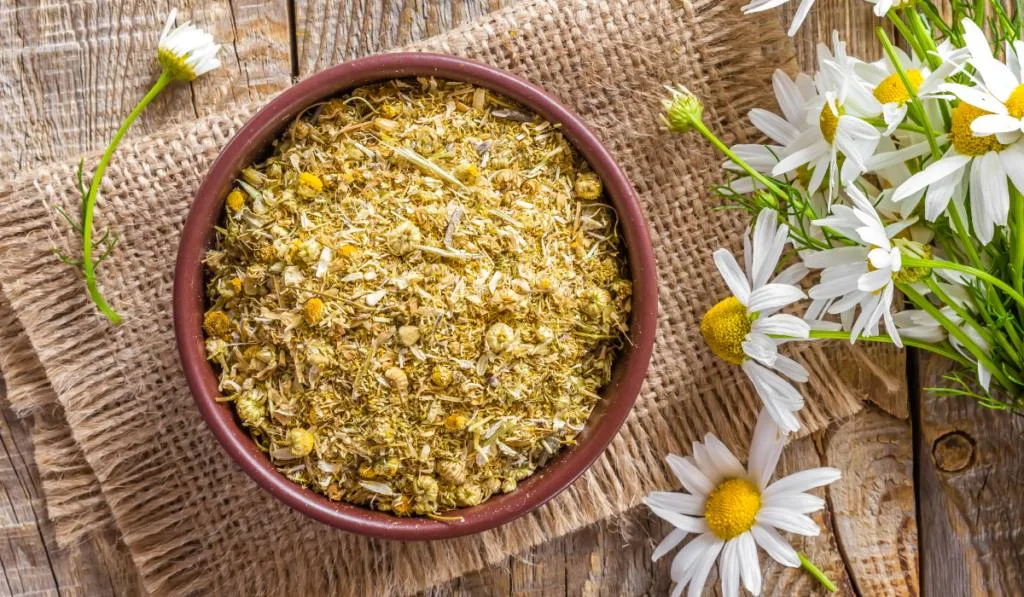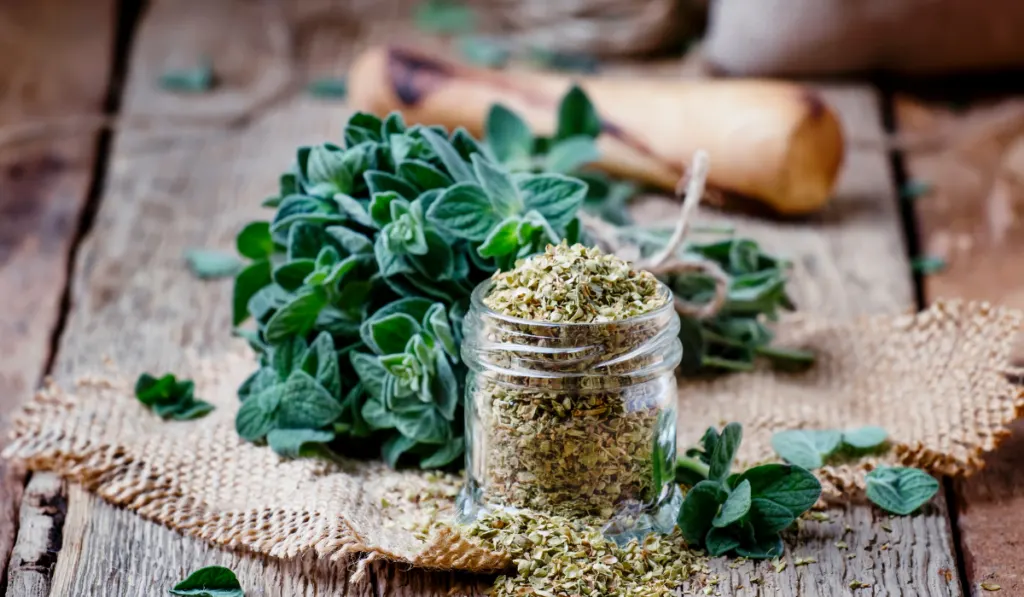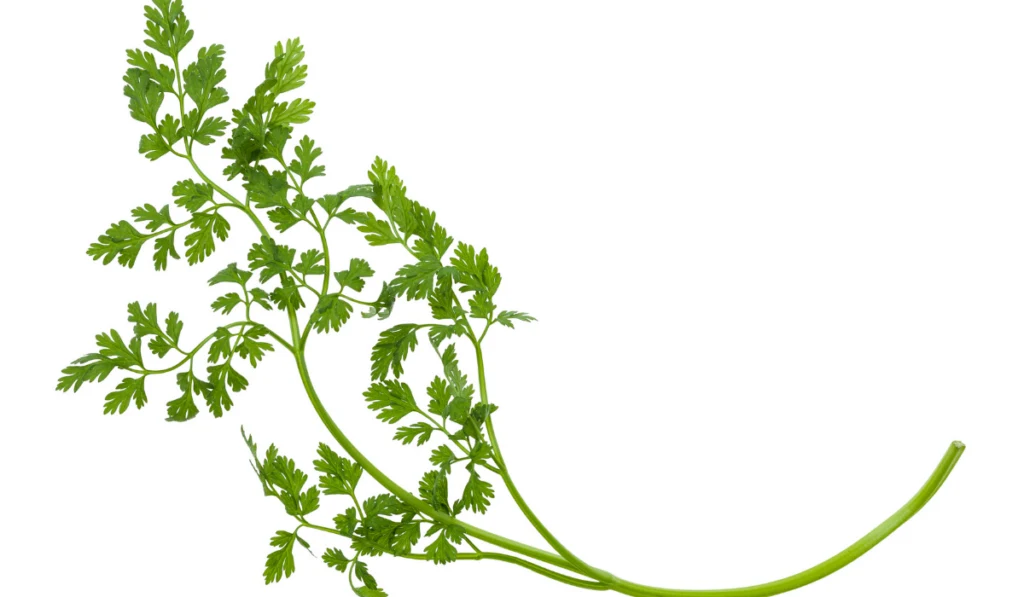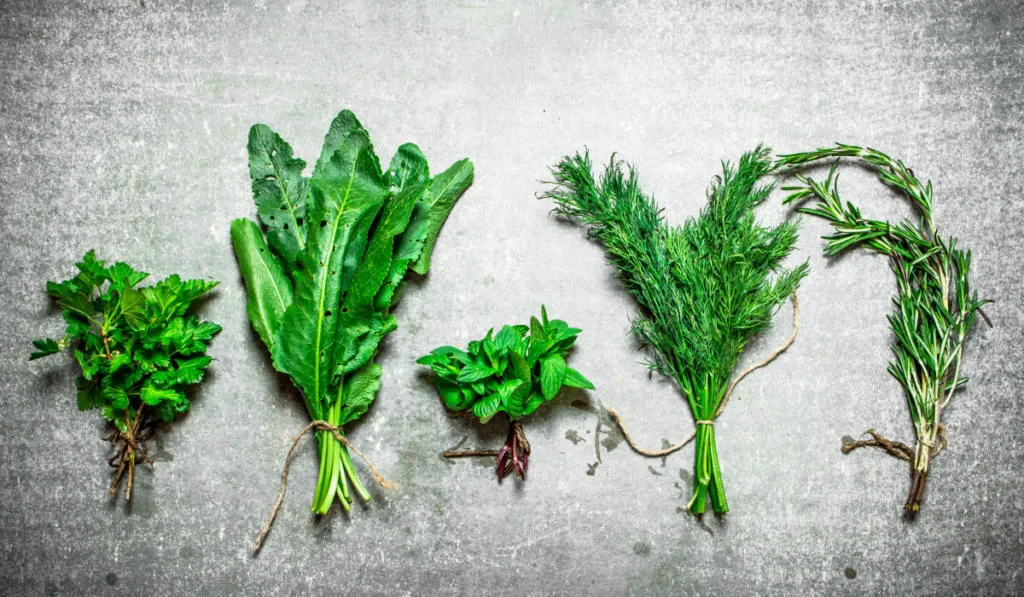Table of Contents
What are Herbs?
Herbs are any form of plant material that is used for its flavor, scent, medicinal, or spiritual purposes. Since time immemorial, humans have associated directly with herbs as a source of medical remedies to several diseases.
Herbs are also well-known for their culinary advantages and have been widely adopted in the kitchen to add taste and flavor to a variety of food. As we know it, most herbs used in cooking are plant leaves. However, not all herbs are leaves, some others are even floral parts.
In this article, I have prepared a list of some of the most popular herbs, their characteristics, and their uses. If you want to add some aroma and fragrances to your cooking, there are endless options for you to choose from, depending on what taste you want.
14 Types of Herbs
Parsley

There are two types of parsley, curly parsley and flat-leaved parsley. Regardless, parsley is a leafy green herb used to enhance food flavors and helps recipes like stews achieve a balanced flavor.
Flat parsley has a peppery taste, while the curly type is relatively bland. Additionally, parsley aids in digestion and keeping the digestive tract healthy, and is abundant in vitamins A and C.
Although parsley is always grown as an annual, in milder climates, parsleys often stand tall and green all winter long and grow into small bushes.
Thyme

There are three kinds of thyme, namely; English thyme, German thyme, and French thyme. The English and the French varieties look similar, featuring green pointy leaves with red-tinted stems. However, the German variety has rounded leaves and a green stem.
Thyme leaves are highly sought-after and work best when blended with other herbs like sage, lavender, and basil. Thyme has a wide range of applications from French, Middle-Eastern, and Asian dishes, where along with other herbs like marjoram and oregano, it is used to make a crucial element called za’atar. This is an herbal blend used in flatbreads like pita, as well as for flavoring roasted poultry and meat.
Chamomile

In Europe and the United States, chamomile has a reputation for being one of the most effective herbs and is widely consumed as herbal tea. Additionally, for thousands of years, chamomile has been traditionally been used as a remedy for stomach disorders, inflammation, fevers, and even anxiety.
There are two kinds of chamomile, German chamomile, and Roman chamomile. Although the two are interchangeable and are equally effective for making tea, the two plants grow differently.
Roman chamomile is a perennial plant that grows to about only a foot high, while German chamomile is an annual, but interestingly grows to about three feet high. The German variety is more popular for its blossoms.
Cutting Celery
Cutting celery is a leafy and aromatic herb that can be used in place of plain celery for a more aromatic flavor and less stringy fibers. Although it is often confused for flat-leafed parsley, cutting celery has dark and glossy leaves with serrated edges attached to spring-like stalks.
Cutting celery leaves and stems are filled with flavors that are useful in complementing salads, soups, vegetables, and stews.
Dill
Also known as dill leaf or dill weed, dill is a strong herb that raises lots of reactions in people. Some claim that they dislike the flavor for being too tangy and earthy, while others praise the flavor as clean and grassy. Dill looks like a fine and more delicate fern with softer leaves like superfine hairs.
Dill is rich in taste suitable for flavoring lamb, fish, peas, and potatoes. In addition, dill has healing powers and is often used to combat digestion issues, reduce swelling, cramps, and even fight bad breath.
The dill plant is exceptionally easy to grow and will even attract useful insects to your gardens such as bees.
Marjoram
Marjoram is also known as sweet or knotted marjoram. Marjoram looks similar to oregano, with green, oval, flat leaves. The two herbs are even used interchangeably.
However, their main difference comes in their flavors. Marjoram has a grassy, lemony flavor that is almost sweet, while oregano has a spicy flavor.
Marjoram leaves are small and attached to woody stems. When dried, marjoram is commonly used in Cypriot, Turkish, and French recipes like the herbes de Provence, a herb blend that is popular in southern France.
In Mexican cuisine, on the other hand, marjoram is blended with thyme and oregano for a robust flavor. Marjoram also goes well with white bean salads, vinaigrettes, tomato sauce, and fish dishes.
Coriander

Coriander is made from the dried seeds of the Coriandrum sativum plant, while cilantro is the leaves and stems of the same plant in either fresh or dried form.
Coriander is used in a wide range of recipes from spicy foods to Asian, Mexican, Indian, Chinese, and Southeast Asian cuisines.
If you want to grow it, coriander thrives well in the early growing season and doesn’t like ground that is too warm. Interestingly, coriander has a couple of other names including dhania, yuen-sai, Pak chee, coriander green, koyendoro, and Mexican parsley.
Oregano

Oregano, also known as wild marjoram, is closely related to sweet marjoram and is native to the warm climates between the Mediterranean and Eurasia. Oregano is typically grown as a perennial plant but can also be grown as an annual in colder climates because it cannot withstand extreme temperatures.
Oreganos have green, flat, and oval leaves that vary in texture anywhere from smooth to fuzzy.
Although it is closely related to the marjoram, oregano has a spicy flavor. However, fresh oregano can be a little hard to find. But that should not be a major concern because dried oregano is even stronger in flavor compared to fresh, so you should use it sparingly.
Additionally, Greek oregano is milder than Mexican oregano, with the Mexican being mostly called for in chili recipes and is popular in Greece for seasoning pizza.
Rosemary
The rosemary herb is a one-of-a-kind herb that grows to develop woody stems and spine-like leaves. It has a strong, evenly pungent, and pine-like fragrance and flavor that is great for adding to dishes like meats, vegetables, fish, and poultry.
Interestingly, both the leaves and stems can be used in cooking, whereby the stems are useful in flavoring roasts and soups as well.
Around Christmas time, you will often see rosemary plants in Christmas tree shapes for sale. Consider purchasing one and keep it for planting when spring approaches. Rosemary plants thrive in dry soils, so you will need to be careful not to overwater the plant whether you keep it inside or out.
If given room to grow, the rosemary often grows into a thick bush. Besides its significance in the kitchen, rosemary also has a nice fragrance that promotes it to be used even in floral arrangements.
Sage

Sage is an aromatic herb with gray-green leaves that are soft and fuzzy to the touch. Its flavor ranges from mild to slightly peppery taste with touches of mint.
Unlike other delicate herbs, sage can be added to the recipe at the beginning of the cooking process. However, this herb is strong and is usually reported to overpower other spices when blended, so you will need to use it sparingly.
For this, sage perfectly pairs with recipes that are considered heavy, creamy, and rich such as meat and dairy products like cheese, and sweet-savory bread.
Besides the rich flavor that sage laces dishes wish, this herb is also known to help relieve cuts, inflammation, and even helps with memory issues. Some even consider it to be the cure-all herb. Additionally, it is easy to grow and maintain, and it attracts good insects like bees to your garden.
Winter Savory
Also known as the bean herb or the mountain savory, the winter savory has a stronger and more pungent peppery flavor compared to summer savory. It has an aromatic flavor that would complement any dish, the most appropriate being fish, poultry, and beans, and their respective stews.
Physically, winter savory has long and thin stalks that grow delicate, narrow green leaves.
Although the winter savory might lose some of its intensity while cooking, it remains aromatic, which is the reason why it is used to flavor liqueurs, and to make beautiful garnishes for any salad.
Medicinally, winter savory is known to have some anti-fungal and antibacterial properties.
Lavender

Lavender is an aromatic herb usually used in salads and top dressings to give whichever dish it is applied on a slightly sweet flavor. In the United States, dried lavender buds and lavender syrup are used for making lavender scones and marshmallows.
Lavender herb plants are known to do well in a wide range of conditions but are known to thrive in full sun exposure with fertile well-drained soil.
Besides the magnificent taste that the lavender adds to dishes, it is known to have soothing effects on insect bites and headaches when combined with other herbs in aromatherapy.
Bergamot (Bee Balm)
Bergamot is an aromatic herb with a minty and slightly spicy taste, making it a great substitute for oregano. This herb is fast gaining fame in the culinary industry, making wonderful additions to bread, salads, pizzas, and many more dishes.
Medicinally, bee balm is known to treat cuts and wounds. Since the plant is also loaded with a naturally occurring antiseptic called thymol, a tea made of the herb is known to cure throat and mouth infections that occur as a result of gingivitis. This naturally occurring antiseptic is highly sought after by many mouthwash brands.
Chervil

This is a unique herb that produces flat, light-green, and lacy leaves with a hint of anise. This flavor enhances and complements the flavor of vegetables, fish, chicken, eggs, and salads.
Chervil is closely related to parsley, and since its adoption in kitchens, it has become a classic herb for most dishes and cuisines.
Although its origin is not exactly known, this herb was most likely introduced to the Europeans by the Romans.
Other Herbs
The list above is by no means an exhaustive list of all the herbs. Among other significant herbs are mints, chives, bay leaves, lemongrass, basil, lemon verbena, stevia, and many others.
Tips for Using Fresh Herbs
How do you use a variety of herbs and still manage to keep the delicate balance of taste while cooking to get the best taste possible?
Well, for you to cook with herbs, you should have some self-control. If you add too much, you will crush other flavors and if you add too little or none at all, then your food becomes bland.
So how do you manage to keep the balance? Here are a few tips:
Look for fresh herbs – Herbs that have their stalks still erect and sturdy mean that they are still fresh. Their leaves should be robust, vibrant in color with no blemishes or spots, and their scent should be strong and fresh.

Use dried herbs in a pinch – Whenever possible, try to use fresh herbs instead of dried herbs. However, if you must use dried herbs, add them to your cooking in small bits, if possible, because they are generally stronger than their fresh versions.
Save fresh herbs for last – When adding fresh herbs to a recipe, save them for the last touches so that the cooking heat doesn’t dampen their flavor.
Refrigerate the herbs – For a longer shelf life of fresh herbs, try refrigerating them. Make sure to wrap the fresh produce with a damp cloth or a piece of paper before refrigerating.
Grow your herbs – Having a fresh supply of herbs is the best thing that could ever happen to someone who loves herbs. This way, there won’t be any rush to use up all the available fresh spices.
Instead, you will be fetching the spices depending on how much you need them. If you are wondering where to start, your local nursery or garden center is a good place to acquire seeds and seedlings.
Conclusion
Herbs have been used to benefit man for centuries. Besides the culinary benefits they have added to kitchens, herbs also have medicinal purposes that vary from one herb to another.
Resources
- https://www.delightedcooking.com/what-are-the-different-types-of-herbs.htm
- https://www.epicurious.com/ingredients/fresh-herbs-how-to-use-them-article
- https://theherbexchange.com/25-best-herbs-to-grow-in-your-kitchen-garden/
- https://leafyplace.com/types-and-list-of-herbs/
- https://www.homestratosphere.com/types-of-herbs/
- https://www.planetnatural.com/herb-gardening-guru/types/
- https://www.tastepak.com/p/herb-types
